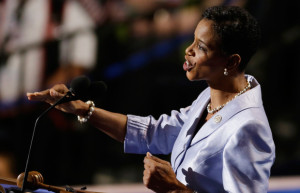>> By >>Vanessa Cárdenas, Vice President for Progress 2050 at the >>Center for American Progress Women of color make up >>18.5 percent of the current U.S. population and >>36.3 percent of the female population,* yet they constitute only >>4.5 percent of the 113th Congress. They are even less well represented >>at the state level; women of color represent only >>5 percent of the total state legislators, and they represent only >>20.8 percent of female state legislators. Finally, they make up >>3.5 percent of governors and are only the mayors of two of the nation’s 100 largest cities.
By >>Vanessa Cárdenas, Vice President for Progress 2050 at the >>Center for American Progress Women of color make up >>18.5 percent of the current U.S. population and >>36.3 percent of the female population,* yet they constitute only >>4.5 percent of the 113th Congress. They are even less well represented >>at the state level; women of color represent only >>5 percent of the total state legislators, and they represent only >>20.8 percent of female state legislators. Finally, they make up >>3.5 percent of governors and are only the mayors of two of the nation’s 100 largest cities.
Why are these statistics problematic? The relative lack of women of color serving in elected office raises grave concerns regarding democratic legitimacy and the fundamental issues of political representation. Lack of representation, of course, can mean a lack of attention to and advocacy for issues important to communities of color. And the underrepresentation of female elected officials in particular translates into a major missed opportunity for the empowerment of underserved communities.
Female politicians have a track record of delivering disproportionately good results for their constituents: According to a >>report from American University’s Women & Politics Institute, female lawmakers in Congress work harder for their constituents, remain more involved with their communities, sponsor more bills, and obtain more co-sponsorship for their legislative initiatives than men. Moreover, women understand the issues women face and, at every level, women officeholders >>prioritize issues of concern to women and families as a part of their policy agenda. This effectiveness extends to other realms as well; research done in the labor movement >>shows that women lead organizers have higher success rates winning certification elections than men do and that women of color have the highest win rates of all.
Women of color elected officials appear to count all underrepresented groups as their core constituencies and work hard on their behalf. For example, a 2006 >>study published in theJournal of Women, Politics & Policy found that, in four states with the highest concentration of Latinos—California, Texas, Arizona, and New Mexico—Latina legislators were more likely than Latino men to consider serving the needs of other ethnic groups, specifically African Americans and Asian Americans, to be a top priority.
Given their effectiveness and commitment to getting things done, why aren’t more women of color running for office and embracing their leadership potential? The barriers holding back women of color are undoubtedly much the same as those shown to limit the political ambitions of all women in general: lack of financial resources, weaker social networks, lack of familiarity with the political process, a greater level of responsibility for children and household tasks, and a greater tendency to be more >>risk-averse than potential male candidates. The lack of >>economic support is perhaps one of the greatest barriers for women of color, as they are often the primary or sole caregivers of their children and their elders, earn less, and have considerably less wealth than men of color and white men and women. What’s more, a >>2009 Center for American Women in Politics study of state legislators found that women of color are even more likely than their non-Hispanic white female colleagues to believe it is harder for women to raise money than men—a belief that is >>no longer founded on truth.
As the Center for American Progress’ “>>The State of Women of Color in the United States” report points out, women of color will make up >>53 percent of our nation’s female population by 2050. To improve their life outcomes, they need to be at the decision-making table. They need to be recruited early on, persistently, and consistently for political office. Fortunately, such efforts have already begun. Organizations such as >>PODER PAC, >>Latinas Represent, >>Higher Heights for America, and the >>Asian-American Women’s Political Initiative offer good examples of initiatives that exist today to fill the void by mentoring, recruiting, offering training for women who want to run for office, and by funding their campaigns early on.
Given our changing demographics, the voices and experiences of women of color are sorely needed at every level of our political system as advocates, political power builders, and changemakers. Their participation is essential to creating a just, inclusive, and forward-moving society that will be inclusive of all communities and thrive and sustain U.S. competitiveness on the global stage.
Vanessa Cárdenas is the Vice President for Progress 2050 at the Center for American Progress.
* Correction, March 7, 2014: This article incorrectly stated the percentage of women of color in the U.S. Population. The correct number is 18.5 percent.
Cross-posted with permission by >>the Center for American Progress.
There are no comments
Add yours